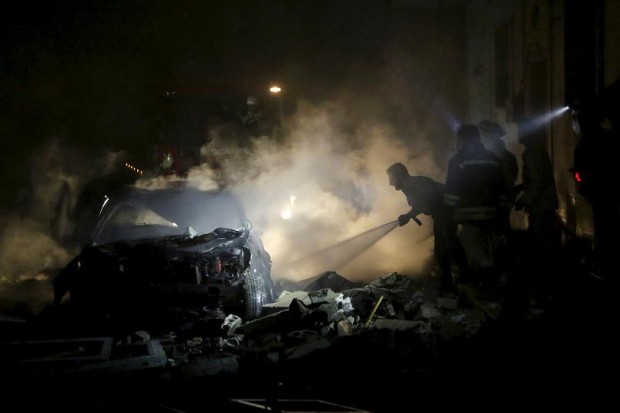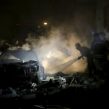
BRIEFS
Publication: Terrorism Monitor Volume: 13 Issue: 13
By:

KURDS IN NORTHERN SYRIA STRIKE MAJOR BLOW AGAINST ISLAMIC STATE
James Brandon
The Kurdish People’s Protection Units (Yekineyen Parastina Gel—YPG) militia struck an important blow against the Islamic State militant organization on June 15 by capturing the strategically important town of Tal Abyad, a key border crossing between Syria and Turkey (Rudaw, June 16). The town (known as Gire Spi in Kurdish) was the nearest border crossing to the Islamic State-held Raqqa, the militant group’s de facto Syrian capital, and was a key transit point for the Islamic State’s weapons, money and recruits. The Islamic State’s loss of the town, which it captured from the Free Syrian Army (FSA) in 2014, means that the Islamic State’s main overland link with Turkey is now located much further to the west, along roads highly vulnerable to U.S. airstrikes. The Kurds’ capture of the town is therefore likely to create important logistical challenges for the Islamic State, as well as to increase the group’s vulnerability to further attack by hampering their lines of communications. Saleh Moslem, the co-president of the YPG’s political wing, the Democratic Union Party (Partiya Yekîtiya Demokrat—PYD), said the Islamic State’s “lifeblood had been cut” by the Kurdish victory (ANF News, June 17).
For the YPG, and its Turkish Kurdish sister organization the Kurdish Workers’ Party (Partiya Karkerên Kurdistanê—PKK), the town’s capture is also of intense strategic importance as it allows the group to link their western enclave of Kobane with their main territories located in the northeast of Syria, as well as further retrenching their current gains. Murat Karayılan, the acting leader of the PKK, said: the town’s capture was “important for Rojava [Syrian] Kurdistan not only because it finally united the two cantons but also because it reaffirmed the liberation of Kobane. Kobanê is no longer under siege and will not be attacked easily” (ANF News, June 17). In response, Iraq’s Kurdistan Regional Government, which has often been inclined to regard the YPG as a potential rival, meanwhile issued a somewhat stilted statement saying that “we highly appreciate the role of other forces along with YPG who cleared the town of ISIS [the previous name of the Islamic State]” (Hawler Times [Erbil], June 17). The YPG, meanwhile, said that it was continuing to attack Islamic State forces in rural areas near the town (ANF News, June 20).
Two important elements of the YPG victory are the group’s close coordination with the United States, which supported it with airstrikes, and its increased cooperation with non-Kurdish groups, such as the mainly Arab and largely secular FSA. It is also attempting to build such coalitions elsewhere. For instance, a YPG commander in the group’s eastern Jazeera canton said earlier in June that it was working with a range of smaller Arab groups, including the Tahrir Brigade, Revolutionaries of Raqqa, Sanadid Brigade, Syriac Military Council and local Arab tribal forces (ARA News, June 13). The long-term durability of such alliances will depend heavily on how the YPG/PYD manages its newly captured territories. The PYD’s Saleh Muslim said that “a civil administration will be formed in which all the social components will be fairly represented,” a reference to Tal Abyad’s complex religious and ethnic mix, which includes not only Kurds but also large numbers of Muslim and Christian Arabs (ARA News, June 18). Significantly, days later on June 25, the Islamic State killed dozens in a substantial attack on Kobane, reportedly after infiltrating the town while disguised as FSA fighters. The attack is likely intended to divert Kurds from moving further towards Raqqa and to sow fresh distrust between local Kurds and Arabs (ARA News, June 26).
The YPG’s capture of the town from the Islamic State also triggered a flood of partisan criticism and thinly-disguised propaganda. From Syria, a group of 12 mainly hardline and predominantly Arab Islamist rebel groups, including Ahrar al-Sham and Jaysh al-Islam, issued a joint statement accusing the YPG forces of implementing “a new sectarian and ethnic cleansing campaign against Sunni Arabs and Turkmen under the cover of coalition airstrikes which have contributed bombardment, terrorising civilians and forcing them to flee their villages” (al-Araby al-Jadeed, June 15). Meanwhile, Harun Yahya, an influential Turkish Islamic televangelist, published a near-hysterical polemic warning that “an attack on the region being carried out by the YPG… [and] coalition planes horrifyingly dropped bombs on the local residents of Tal Abyad,” and also that “a communist state is being built on the Turkish border with U.S. help, and that communist state intends to spread violence across the world” (Arab News [Jeddah], June 20). Al-Jazeera, the Qatar-based and funded channel, meanwhile gave heavy coverage to an alleged exodus of Arabs from Tal Abyad, likely reflecting the pan-Arabist and pro-Islamist sympathies of its owners (al-Jazeera, June 19). This flood of verbal attacks suggests the difficulties that the Syrian Kurds and the YPG, in particular, will face as they seek to secure their recent gains, even though their recent victory has underlined that they remain the only non-Islamist rebel force capable of effectively opposing the Islamic State in Syria. One effect of this campaign is that the group continues to maintain relations with the Syrian government, one of the few regional powers that has not verbally or physically attacked it; for instance, on June 15, the day before the capture of Tal Abyad, the Syrian prime minister, Wael al-Halaqi, made an unprecedented and apparently cordial visit to the YPG-controlled cities of Qamishli and al-Hasakah (Rudaw, June 15). This underlines that the YPG remains far more concerned with liberating Kurdish territories from the Islamic State and establishing some form of self-rule than with the broader dynamics of the Syrian civil war. Indeed, with each fresh victory such as Tel Abyad, the PYD brings an increasing proportion of Kurdish-inhabited territory under its control leaving less under the control of the Islamic State, a trend which, if continued, is likely to mean the more successful the group is against the Islamic State the more it is likely to progressively withdraw from the fight against the group to focus on its own internal state-building.
AQAP, ISLAMIC STATE RESURGENT IN YEMEN
James Brandon
A U.S. drone strike in Yemen’s eastern Hadramawt province on June 12 killed Nasir al-Wuhayshi, the amir of al-Qaeda in the Arabian Peninsula (AQAP), al-Qaeda’s official subsidiary in the country (al-Jazeera, June 17). His death was later confirmed by AQAP, which shortly afterward executed two alleged spies in al-Mukalla, put their bodies on public display and distributed the images on social media (Mukalla Star, June 19). The group also announced that Qasim al-Raymi, formerly the group’s military commander, would now become its overall leader (Daily Star [Beirut], June 16). The impact of the leadership change on the group is currently unclear. Although al-Wuhayshi was a long-standing, charismatic and experienced leader, as well as one of the highest profile jihadists in the Middle East, his replacement is also experienced and is likely to prove equally capable in the long-run.
Underlining that the jihadist challenge in Yemen is far bigger than al-Wuhayshi, Sunni jihadists in recent weeks continued to launch attacks against the Houthis, the Zaydi Shi’a movement that currently controls the capital Sana’a. Most recently, on June 20, a car bomb exploded outside a mosque in Sana’a’s Old City used by the Houthis, killing two people (Saba News, June 20). The Islamic State, AQAP’s rival, later claimed responsibility for the attack. Three days earlier, on June 17, two car bombs had targeted two mosques in Old Sana’a known to have been regularly worshipped at by the Houthis, killing two people and wounding 60, although no group claimed responsibility (Saba News, June 18). At the same time, Saudi airstrikes against both military and other targets linked to the Houthis and their allies from the regular Yemeni military have continued in Sana’a and elsewhere, for instance targeting the Ministry of Defense in the capital on June 12 (Yemen Times, June 12). Saudi airstrikes on the same day also destroyed several civilian houses in the Old City, although a Saudi military spokesman Ahmed Assiri unconvincingly claimed that Saudi “has not performed any operations in these historic districts and has not targeted ancient Sana’a” (Gulf News, June 13). Given the international opprobrium that descended on Saudi Arabia after the bombing of the Old City, a UNESCO World Heritage Site, it was perhaps fortuitous for Riyadh that historic Houthi-frequented mosques in the same areas were shortly afterwards struck by car bombs, only one of which was claimed by the Islamic State, causing collateral damage to houses and nearby civilians but not to Saudi Arabia’s reputation.
Indeed, one of the most important factors in Yemen in coming months will be the precise relations between AQAP and other anti-Houthi elements, including Saudi Arabia, Qatar and the beleaguered government of internationally-recognized prime minister, Abd Rabbu Mansour Hadi. Just as al-Qaeda’s official affiliate in Syria, Jabhat al-Nusra, is being increasingly openly backed by Qatar and other Sunni-ruled countries against both the more extreme Islamic State and the country’s Shi’a-led government, so it is possible that such countries may also seek to use AQAP against the Houthis in the coming months, particularly given the failure of either Hadi loyalists or airstrikes to dislodge the Houthis from the capital and other areas. Underlining the risk that Saudi Arabia, Hadi’s internationally recognized government and other regional powers could begin working with AQAP is the fact that one member of Hadi’s delegation to recent Geneva peace-talks was Abd al-Rahman al-Humayqani; al-Humayqani, in December 2013, was named a Specially Designated Global Terrorist by the U.S. Treasury on account of his close links to AQAP (Middle East Eye, June 19). The U.S. government at the time said that “Humayqani was an important figure within AQAP and reportedly had a relationship with important AQAP leaders,” and had “provided financial support and other services to AQAP and acted for or on behalf of the group,” a view which it has not retracted (U.S. Treasury Department, December 18, 2013). A further indication of the potentially converging interests of Hadi, Saudi Arabia and AQAP occurred in Hadramawt province on June 20, when gunmen on motorbikes—a form of assassination previously used by AQAP—shot dead Hussein Abdul Bari al-Aidaroos, a popular and moderate Sunni imam from Shibam, who had been known as an outspoken critic of the Saudi airstrikes (Saba News, June 20). The above incidents underline that the present chaos in Yemen is creating complex and potentially dangerous new political realignments, not least because of the potential for the Western-backed government of Yemen, increasingly desperate to retake the capital from the firmly entrenched Houthis, to empower a newly resurgent AQAP, a bitter enemy of the Houthis, in order to do so.





